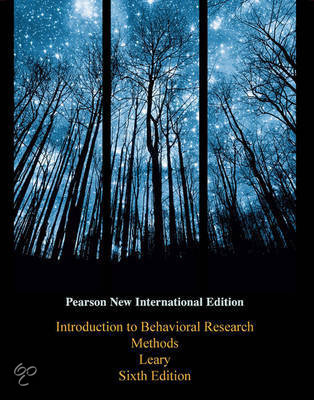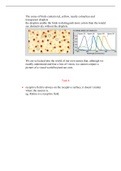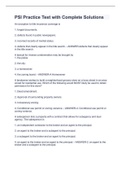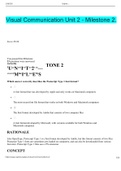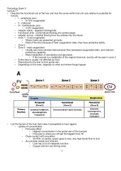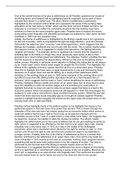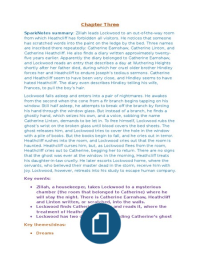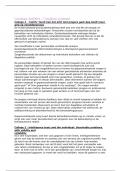Designing Research
Final exam:
● Leary: chapter 1, 2 (skip sections on Effect size and meta-analysis) , 3, 4, 5, 9, 11,
15, 12
● Podesva & Sharma: chapter 13 and 21
● Popper: chapter 1
Leary Chapter 1: Research in the Behavioral Sciences
Beginning of Behavioral Research
- Aristotle: questions about the nature of humans
- Gautama Buddha: psychological insight into human thought, emotion and behavior
→ Speculative approach; NOT scientific, no way to test the validity of their explanations
Behavioral Research: Applying scientific methodologies to the study of behavior, thought
and emotion
Basic Research: Understanding psychological processes without regard for whether or not
the knowledge is immediately applicable → To increase knowledge
Applied Research: Finding solutions for certain problems rather than to enhance general
knowledge
Evaluation Research/ program evaluation: Using behavioral research methods to assess
the effects of social or institutional programs on behavior.
- Basic Research provides the foundation on which Applied Research rests.
- Applied Research provides ideas and new questions for Basic Research.
3 goals for Behavioral Research:
- description: describing patterns of behavior
- predicting: predicting behavior by analyzing data
- explaining: explaining phenomena
Common sense can interfere with scientific progress.
→ Scientists must question their common sense assumptions and minimize the impact of
those assumptions on their work.
3 criteria for an investigation to be scientific:
(1) Systematic Empiricism
Drawing conclusions from what can be objectively observed in a systematic way.
(2) Public Verification
Research must be conducted in such a way that it can be observed, replicated and
verified.
(3) Solvable Problems
Investigate questions that are answerable given current knowledge and research
techniques.
1
,Detecting phenomena to gather information before making a theory, also explaining
phenomena beforehand.
Theory: Set of propositions that attempts to explain the relationship among a set of
concepts. ( → Theories are supported by empirical findings.)
Criteria of a theory:
● proposes causal relationships
● is coherent and clear
● is parsimonious; using a few concepts as possible to explain the target phenomenon
● generates testable hypothesis
● stimulates other research
● solves an existing theoretical question
A model describes how concepts are related, a theory describes how and why they are
related. Model describes relationships, theory explains.
Post hoc explanations: Explanations that are made after the fact.
A priori: Before collecting data.
Theories are too broad to be tested directly, hypotheses are tested directly so that the
theory is tested indirectly.
Deduction: Reasoning from a general proposition to specific implications of that
preposition.
- From theory to hypotheses (several)
- If the first two premises are true, the conclusion/hypothesis is also true.
- "All spiders have eight legs. A tarantula is a spider. Therefore, tarantulas have eight
legs."
Hypotheses: Testing part of the theory.
Induction: Collecting a hypothesis from a collection of facts.
- From observed facts to one hypothesis.
Empirical generalizations: Hypotheses based on previously observed patterns of results.
Falsification: A hypothesis must be able to find false.
Methodological pluralism: Using many different methods and designs to test a theory.
Strategy of strong inference: Simultaneously testing the opposing predictions of two
theories. It allows researchers to draw stronger conclusions.
Conceptual Definitions: Descriptive definition which is not specific enough for research.
Operational Definitions: Defining a concept by specifying how the concept is measured or
induced in a particular study.
→ Terms must be defined in order to falsify a hypothesis.
Theories can not be proven or disproved.
- A theory is not proved if the hypothesis is proved.
- The example of Jake the murderer ??????
2
, - If a hypothesis is falsified this does NOT mean that the theory is false too
→ a failing hypothesis can be due to a number of factors other than the theory not
being true such as poor measurements or techniques.
Null findings: results showing that certain variables are not related.
→ These researches are not relevant because you never know if the method of the theory
was wrong.
File-drawer problem: the failure to publish studies that obtain null findings.
→ so other researchers won’t conduct the same research
The scientific filter
Filter 1: Filters out nonsense
- On the basis of scientific training, concern for professional reputation, availability for
funding
Filter 2: Filters out dead ends and fringe topics
- On the basis of self-judgment of viability
Filter 3: Filters out methodological biases and errors and unimportant contributions
- On the basis of peer reviews
Filter 4: Filters out nonreplication, uninteresting and non useful stuff
- On the basis of replication and extension by others
- After research has published
Strategies of behavioral research
Descriptive Research: Describes behavior, thought or feeling of a group of individuals
provides the foundation for other research.
Correlational Research: Investigates relationships among various variables.
Experimental Research: The researcher manipulates one variable to see whether changes
in behavior occur.
Quasi-Experimental Research: The researcher does not vary an IV and just studies a
natural event or the researcher manipulates an IV but does exercise the same control over
extraneous factors as in a true experiment.
Popper chapter 1
Induction: from singular statements, observations to universal statements, a hypothesis.
3
Final exam:
● Leary: chapter 1, 2 (skip sections on Effect size and meta-analysis) , 3, 4, 5, 9, 11,
15, 12
● Podesva & Sharma: chapter 13 and 21
● Popper: chapter 1
Leary Chapter 1: Research in the Behavioral Sciences
Beginning of Behavioral Research
- Aristotle: questions about the nature of humans
- Gautama Buddha: psychological insight into human thought, emotion and behavior
→ Speculative approach; NOT scientific, no way to test the validity of their explanations
Behavioral Research: Applying scientific methodologies to the study of behavior, thought
and emotion
Basic Research: Understanding psychological processes without regard for whether or not
the knowledge is immediately applicable → To increase knowledge
Applied Research: Finding solutions for certain problems rather than to enhance general
knowledge
Evaluation Research/ program evaluation: Using behavioral research methods to assess
the effects of social or institutional programs on behavior.
- Basic Research provides the foundation on which Applied Research rests.
- Applied Research provides ideas and new questions for Basic Research.
3 goals for Behavioral Research:
- description: describing patterns of behavior
- predicting: predicting behavior by analyzing data
- explaining: explaining phenomena
Common sense can interfere with scientific progress.
→ Scientists must question their common sense assumptions and minimize the impact of
those assumptions on their work.
3 criteria for an investigation to be scientific:
(1) Systematic Empiricism
Drawing conclusions from what can be objectively observed in a systematic way.
(2) Public Verification
Research must be conducted in such a way that it can be observed, replicated and
verified.
(3) Solvable Problems
Investigate questions that are answerable given current knowledge and research
techniques.
1
,Detecting phenomena to gather information before making a theory, also explaining
phenomena beforehand.
Theory: Set of propositions that attempts to explain the relationship among a set of
concepts. ( → Theories are supported by empirical findings.)
Criteria of a theory:
● proposes causal relationships
● is coherent and clear
● is parsimonious; using a few concepts as possible to explain the target phenomenon
● generates testable hypothesis
● stimulates other research
● solves an existing theoretical question
A model describes how concepts are related, a theory describes how and why they are
related. Model describes relationships, theory explains.
Post hoc explanations: Explanations that are made after the fact.
A priori: Before collecting data.
Theories are too broad to be tested directly, hypotheses are tested directly so that the
theory is tested indirectly.
Deduction: Reasoning from a general proposition to specific implications of that
preposition.
- From theory to hypotheses (several)
- If the first two premises are true, the conclusion/hypothesis is also true.
- "All spiders have eight legs. A tarantula is a spider. Therefore, tarantulas have eight
legs."
Hypotheses: Testing part of the theory.
Induction: Collecting a hypothesis from a collection of facts.
- From observed facts to one hypothesis.
Empirical generalizations: Hypotheses based on previously observed patterns of results.
Falsification: A hypothesis must be able to find false.
Methodological pluralism: Using many different methods and designs to test a theory.
Strategy of strong inference: Simultaneously testing the opposing predictions of two
theories. It allows researchers to draw stronger conclusions.
Conceptual Definitions: Descriptive definition which is not specific enough for research.
Operational Definitions: Defining a concept by specifying how the concept is measured or
induced in a particular study.
→ Terms must be defined in order to falsify a hypothesis.
Theories can not be proven or disproved.
- A theory is not proved if the hypothesis is proved.
- The example of Jake the murderer ??????
2
, - If a hypothesis is falsified this does NOT mean that the theory is false too
→ a failing hypothesis can be due to a number of factors other than the theory not
being true such as poor measurements or techniques.
Null findings: results showing that certain variables are not related.
→ These researches are not relevant because you never know if the method of the theory
was wrong.
File-drawer problem: the failure to publish studies that obtain null findings.
→ so other researchers won’t conduct the same research
The scientific filter
Filter 1: Filters out nonsense
- On the basis of scientific training, concern for professional reputation, availability for
funding
Filter 2: Filters out dead ends and fringe topics
- On the basis of self-judgment of viability
Filter 3: Filters out methodological biases and errors and unimportant contributions
- On the basis of peer reviews
Filter 4: Filters out nonreplication, uninteresting and non useful stuff
- On the basis of replication and extension by others
- After research has published
Strategies of behavioral research
Descriptive Research: Describes behavior, thought or feeling of a group of individuals
provides the foundation for other research.
Correlational Research: Investigates relationships among various variables.
Experimental Research: The researcher manipulates one variable to see whether changes
in behavior occur.
Quasi-Experimental Research: The researcher does not vary an IV and just studies a
natural event or the researcher manipulates an IV but does exercise the same control over
extraneous factors as in a true experiment.
Popper chapter 1
Induction: from singular statements, observations to universal statements, a hypothesis.
3

